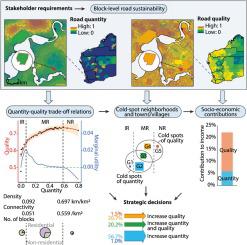International Journal of Applied Earth Observation and Geoinformation ( IF 7.6 ) Pub Date : 2021-10-28 , DOI: 10.1016/j.jag.2021.102585 Yongze Song 1 , Peng Wu 1 , Keith Hampson 2 , Chimay Anumba 3

|
Increasing quantity and quality of roads are pathways to sustainable road infrastructure development. Understanding quantity-quality relations of road sustainability is critically required for strategic decision making. However, few knowledge are available about assessing quantity-quality relations of road sustainability from a perspective of spatial disparities. Here, we developed a Spatial Trade-Off Relation (STOR) model for assessing road quantity-quality trade-off relations at 42,425 blocks in Western Australia (WA). First, a sustainable road infrastructure index (SRII), including quantity and quality phases, was developed regarding stakeholder requirements and using multiple spatial methods to examine block-level road sustainability. Next, quantity-quality trade-off relations for road sustainability was investigated using a diminishing marginal utility approach. Further, spatial disparities of quantity-quality trade-offs were assessed through the spatial clustering based identification of hotspots and cold spots in trade-offs. Finally, contributions of the road quantity-quality interaction to economic development were estimated with the consideration of non-linear and geographically local characteristics of the associations using a generalized additive model and geographically weighted regression. We found three stages of the quantity-quality relations of road sustainability, including the increasing, marginal, and negative returns. The increasing return revealed the simultaneous growth of quantity and quality in outer and remote regions, and marginal and negative returns were primarily located in major cities. In addition, regional disparities of the trade-offs were found from the identified blocks, towns and villages, where quantity and quality were spatially clustered, for informing priorities of future strategic decisions. We also found that the contribution of road quality was about three times the contribution of quantity to resident income. This study demonstrated that efforts regarding regional quantity-quality trade-offs were required to achieve global sustainable infrastructure development goals.
中文翻译:

使用空间权衡关系模型评估块级可持续交通基础设施发展
增加道路的数量和质量是实现可持续道路基础设施发展的途径。了解道路可持续性的数量-质量关系对于战略决策至关重要。然而,从空间差异的角度评估道路可持续性的数量-质量关系的知识很少。在这里,我们开发了一个空间权衡关系 (STOR) 模型,用于评估西澳大利亚 (WA) 42,425 个街区的道路数量-质量权衡关系。首先,根据利益相关者的要求制定了可持续道路基础设施指数 (SRII),包括数量和质量阶段,并使用多种空间方法来检查街区级道路的可持续性。下一个,使用递减边际效用方法研究了道路可持续性的数量-质量权衡关系。此外,通过基于空间聚类的权衡热点和冷点识别来评估数量-质量权衡的空间差异。最后,使用广义加性模型和地理加权回归,在考虑关联的非线性和地理局部特征的情况下,估计了道路数量-质量相互作用对经济发展的贡献。我们发现了道路可持续性数量质量关系的三个阶段,包括递增、边际和负回报。收益递增揭示了边远地区数量和质量的同步增长,边际和负回报主要位于主要城市。此外,从确定的街区、城镇和村庄中发现了权衡的区域差异,其中数量和质量在空间上聚集,为未来战略决策的优先事项提供信息。我们还发现,道路质量对居民收入的贡献大约是数量贡献的三倍。这项研究表明,要实现全球可持续基础设施发展目标,需要在区域数量与质量之间进行权衡。我们还发现,道路质量对居民收入的贡献大约是数量贡献的三倍。这项研究表明,要实现全球可持续基础设施发展目标,需要在区域数量与质量之间进行权衡。我们还发现,道路质量对居民收入的贡献大约是数量贡献的三倍。这项研究表明,要实现全球可持续基础设施发展目标,需要在区域数量与质量之间进行权衡。











































 京公网安备 11010802027423号
京公网安备 11010802027423号